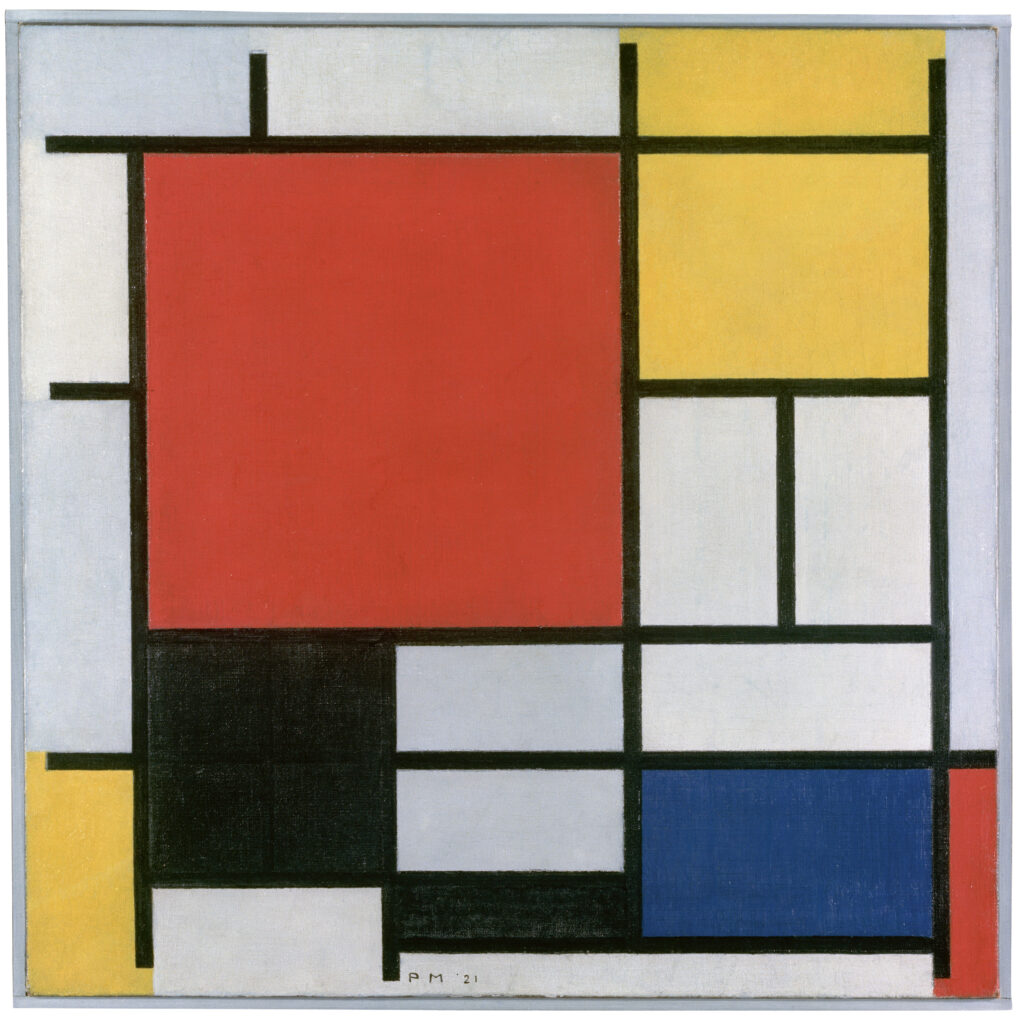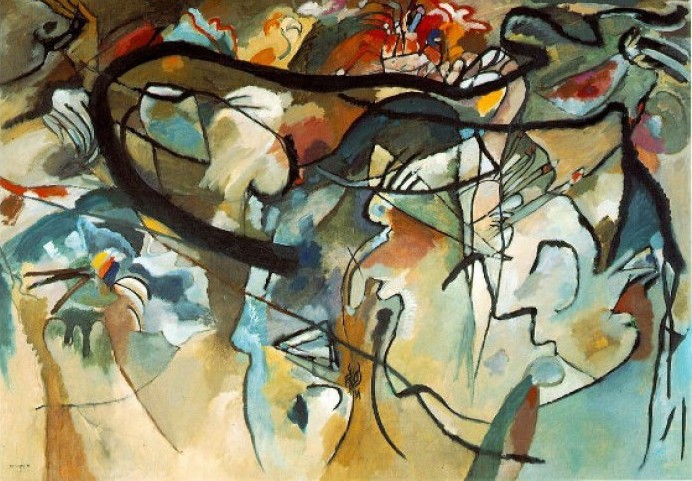Geometric abstraction
Geometric abstraction is a form of abstract art based on the use of geometric shapes such as squares, circles and triangles, emphasize the visual relationships between shapes, colors, and lines to create non-representational artworks. These forms are often arranged in non-representational (non-objective) compositions, meaning that they do not represent any recognizable objects from the natural world. Geometric abstraction can be traced back to the early 20th century, when artists such as Piet Mondrian and Kazimir Malevich began to explore the expressive potential of geometric forms.
Geometric abstraction aims to explore the inherent qualities of geometric shapes, such as their symmetry, balance, and precision. It often rejects the depiction of recognizable objects or subjects in favor of pure abstraction. Artists working in this style may employ various mediums, including painting, sculpture, and graphic design, to create their artworks.
Geometric abstraction is an artistic style that emerged in the early 20th century, it reached its peak in the 1950s and 1960s, when it was embraced by a number of influential artists, including Ellsworth Kelly, Josef Albers, and Agnes Martin. During this period, geometric abstraction was often associated with the Minimalist movement, which emphasized the use of simple, geometric forms and the elimination of unnecessary detail.
Today, geometric abstraction continues to be a popular form of abstract art. It is often used in graphic design, architecture, and fashion, and it can be found in the work of artists from around the world.
Key figures associated with geometric abstraction include artists such as:
Kazimir Malevich
Piet Mondrian
Wassily Kandinsky
László Moholy-Nagy
Josef Albers
Ellsworth Kelly
Agnes Martin
Bridget Riley
Sol LeWitt
Frank Stella
These artists sought to create art that emphasized the spiritual, universal, and timeless aspects of visual language, breaking away from traditional representational forms.
Geometric abstraction continues to be influential and is celebrated for its emphasis on form, color, and composition. It has had a significant impact on various art movements and continues to inspire contemporary artists today.
Here are some of the most famous works of geometric abstraction:

Piet Mondrian, Composition with Red, Blue, Yellow, and Black (1921)
Mondrian’s Composition with Red, Blue, and Yellow demonstrates his commitment to relational opposites, asymmetry, and pure planes of color. Mondrian composed this painting as a harmony of contrasts that signify both balance and the tension of dynamic forces. Mondrian viewed his black lines not as outlines but as planes of pigment in their own right; an idea seen in the horizontal black plane on the lower right of the painting that stops just short of the canvas edge (see image above). Mondrian eradicates the entire notion of illusionistic depth predicated on a figure in front of a background. He achieves a harmonious tension by his asymmetrical placement of primary colors that balance the blocks of white paint. Notice how the large red square at the upper right, which might otherwise dominate the composition, is balanced by the small blue square at the bottom left. What’s more, when you see this painting in a person you can discern just how much variation is possible using this color scheme—and that Mondrian used varying shades of blacks and whites, some of which are subtly lighter or darker. Seen up close, this variety of values and textures create a surprising harmony of contrasts. Even the visible traces of the artist’s brushwork counter what might otherwise be a rigid geometric composition and balance the artist’s desire for a universal truth with the intimately personal experience of the artist.
“Composition with Red, Blue, and Yellow” by Piet Mondrian: This iconic painting is a prime example of Mondrian’s exploration of geometric forms and primary colors. It features a grid of rectangles filled with solid red, blue, and yellow, accompanied by intersecting black lines.
Kazimir Malevich, Suprematist Painting (1916-17)
This abstract art style explores pure color and pure light, representing a new realism in painting according to Malevich. The painting features geometric shapes such as squares, rectangles and circles in black, white and various shades of red against a white background.
“Black Square” by Kazimir Malevich: Malevich’s “Black Square” is considered a pioneering work of geometric abstraction. It consists of a simple black square painted on a white background, representing a rejection of traditional representation and a quest for pure form.

Wassily Kandinsky, Composition VII (1913)
“Composition VII” (1913) by Wassily Kandinsky is considered by many abstract art aficionados to be the most important painting of the 20th Century—perhaps even the most important abstract painting ever created. Yet frequently when someone looks at it for the first time they react negatively, expressing anger, frustration, or even disgust. Undeniably, it is a difficult painting, especially for those who are new to abstract art. First of all, it is massive, measuring 200 x 300 centimeters. Secondly, the surface is entirely covered with countless overlapping amorphous forms, seemingly random lines, and a minefield of colors, some vivid and some blurred. Nothing references the known natural world. Only the illusion of depth is perceptible, but the space into which it recedes bears no semblance to reality. The painting could easily look like nonsense to anyone unwilling to work towards unravelling its mysteries. But for those willing to study it with an open mind, “Composition VII” can pay enough intellectual, visual, and even spiritual dividends to last a lifetime. And I am not being hyperbolic. This painting truly is that important to some people—not only because of its visual, physical, or formal qualities either, but because for Kandinsky and those who appreciate him, “Composition VII” has come to be understood as a concrete embodiment of spiritual purity in art.
“Composition VII” by Wassily Kandinsky: Kandinsky’s “Composition VII” is a complex and dynamic painting featuring intersecting lines, geometric shapes, and vibrant colors. It showcases his interest in the spiritual and emotional power of abstract art.
László Moholy-Nagy, Untitled (1923-25)
In “Untitled” (1923-25), Moholy-Nagy explores the principles of geometric abstraction. The composition consists of intersecting lines, shapes, and planes, creating a dynamic and visually engaging arrangement. Moholy-Nagy’s use of geometric forms reflects his interest in the relationship between art, technology, and society.
This artwork exemplifies Moholy-Nagy’s innovative approach to art-making and his exploration of the possibilities of abstraction. Through his use of geometric elements, he sought to create a visual language that conveyed the energy and dynamism of the modern world. “Untitled” (1923-25) stands as a testament to Moholy-Nagy’s contributions to the development of geometric abstraction and his lasting influence on the art world.
Josef Albers, Homage to the Square: With Red (1950)
Homage to the Square: Apparition, painted in 1959, is a disarmingly simple work, composed of four superimposed squares of oil color applied with a palette knife directly from the tube onto a white, primed Masonite panel. It is part of a series that Albers began in 1950 and that occupied him for 25 years.
“Homage to the Square” series by Josef Albers: Albers’ series of paintings explores the interaction of colors within nested squares. These works demonstrate the artist’s meticulous study of color relationships and optical illusions.
Ellsworth Kelly, Red Blue Green (1959)
Agnes Martin, The Tree (1959)
Bridget Riley, Movement in Squares (1961)
Sol LeWitt, Wall Drawing #1180 (1979)
Frank Stella, Die Fahne Hoch! (1959)
Geometric abstraction has produced numerous notable works that have made a significant impact on the art world. Here are some of the most famous works associated with this artistic style:



